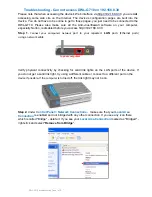
Use Cases/Tutorials
p. 210
G-RACK 12 RAID Guide
Overview
Traditionally, the mass storage devices are based on mechanical hard drives (HD). Although SSDs
are coming, classical HDs remain the preferred solution for computers ranging from notebook to
servers. HDs provide a huge amount of space at a small cost, though at the same time they are not
very reliable for data storage and backups. Modern world challenges businesses to tailor a solution
with disk fault tolerance and high performance as must-haves.
What is RAID?
RAID stands for “Redundant Array of Independent Disks” and was first used in 1988. RAID technology
was developed to improve data protection and performance, while storing large amounts of data. It
allows to group multiple physical disks into a logical drive and apply one the the existing RAID levels.
Depending on the RAID level selected, performance, redundancy, storage capacity and reliability of
the logical drive will differ. Most levels offer redundancy against drive failure.
Different RAID levels: drawbacks, advantages and tradeoffs
There are several RAID levels or configurations that are defined and standardized upon and also
some of the hybrid RAID configurations.
RAID Level
Description
Advantage
Drawbacks
Ideal For
JBOD
Just-a-bunch-of-
disks
Each drive can be ac-
cessed as an individ-
ual volume. Usable
storage capacity is
100% of total avail-
able storage
No fault tolerance
Audio applications
RAID 0
Disk striping
Offers the highest
performance and a
100% of total avail-
able storage capacity
No fault tolerance
- failure of one drive
in the array results in
complete data loss
Content creation ap-
plications requiring
highest performance
and storage capacity
Содержание G-RACK 12
Страница 1: ......
Страница 2: ...Copyrights...
Страница 4: ...Introduction...
Страница 9: ...Getting Started...
Страница 12: ...Getting Started p 12 Front View Rear View...
Страница 31: ...Getting Started p 31 All settings can be changed manually in the G RACK 12 Administrative Tool at any time...
Страница 32: ...Administrative Tool...
Страница 41: ...Administrative Tool p 41 Delete Workspace To delete a workspace highlight the workspace and click Delete button...
Страница 48: ...Administrative Tool p 48 Extended information from smartctl utility...
Страница 77: ...Administrative Tool p 77 SMB CIFS Workspaces Add a workspace that will connect via SMB CIFS service...
Страница 92: ...Administrative Tool p 92 Comment Optional comment text box...
Страница 109: ...Administrative Tool p 109 Example error message...
Страница 124: ...Administrative Tool p 124 Memory usage Network interfaces...
Страница 130: ...Hardware Description...
Страница 159: ...Use Cases Tutorials...
Страница 180: ...Use Cases Tutorials p 180...
Страница 184: ...Use Cases Tutorials p 184 You need to click the enable slider to activate this option...
Страница 191: ...Use Cases Tutorials p 191 Lastly a review is presented before the shares are created...
Страница 192: ...Use Cases Tutorials p 192 Once you confirm the process starts...
Страница 215: ...Use Cases Tutorials p 215 6 The RAID is ready...
Страница 221: ...iSCSI Essentials...
Страница 228: ...iSCSI Essentials p 228 Links and references https en wikipedia org wiki ISCSI...
Страница 234: ...Troubleshooting...
Страница 247: ...F A Q...
Страница 272: ...Technical Support Warranty...
Страница 283: ...Glossary...
Страница 289: ...Appendices...
















































